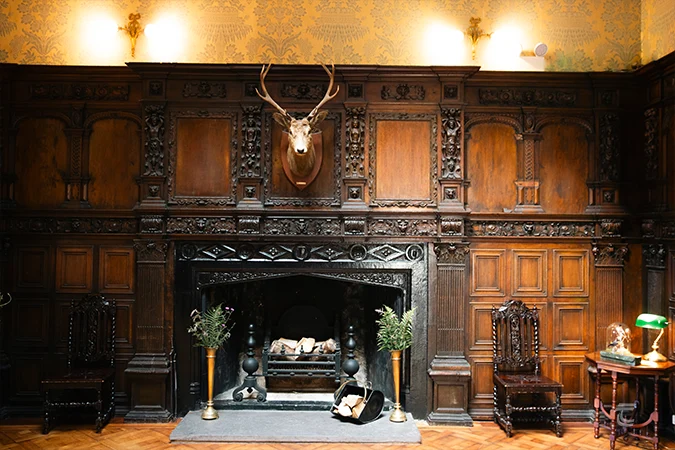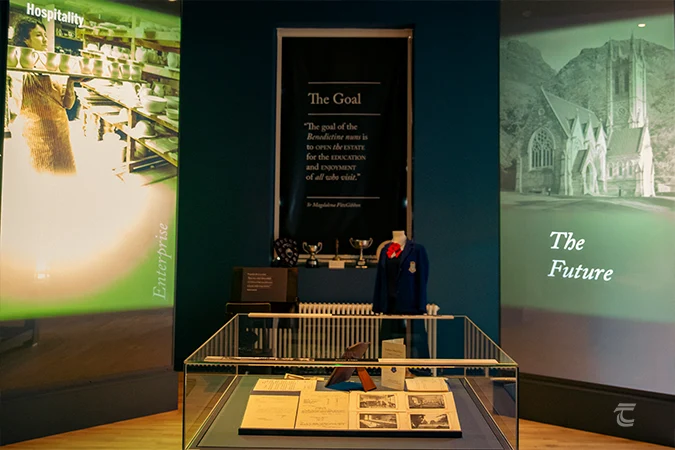Kylemore Abbey
The magnificent Kylemore Castle, later to become popularly known as Kylemore Abbey, was built between 1864 and 1871 for Dr Mitchell Henry, who was from a wealthy family of cotton magnates in Manchester, England. Mitchell was well educated, and initially became a surgeon specialising in diseases of the eye, before he joined the family mercantile business. He unsuccessfully stood for parliament as a liberal candidate three times, and founded the famous Manchester Evening News before selling it to the printer William Evans. Mitchell married Margaret Vaughan of County Down in 1849. During their honeymoon in Connemara, Margaret fell in love with the wild landscape here at Kylemore. Mitchell purchased a hunting lodge with an extensive estate, and had a grand house constructed in the flamboyant baronial style to the design of Samuel Ussher Roberts, and later James Franklin Fuller. Reputedly, it took over 100 men to build it, using granite shipped by sea from Dalkey and Ballinasloe limestone.
Mitchell and Margaret were passionate and engaged with trying to improve the life of the people of Connemara, who they saw as impoverished and neglected. He spent much of his fortune on land reclamation and agricultural improvements, he founded schools and was known as a generous economic benefactor of the whole Connemara area.
‘My time, my fortune and my personal exertions have been given to the improvement of the neglected people of the West of Ireland.’
The clear air of Connemara made for a wonderful retreat from the industrial smog of Victorian London. The Henrys loved walking in the stunning Connemara landscapes that surround Kylemore. The family and their guests enjoyed fishing and hunting in the estate. Margaret revelled in the role of a country lady. Her tastes were reflected in the beautiful interiors and gardens of Kylemore. The house was well set up for entertaining, with a ballroom, a billiards room, a turkish bath and tennis courts.
Kylemore Abbey was finally completed in 1874. However, Margaret did not live long to enjoy her beautiful new home. Just four years after it was finished, she fell ill during a holiday in Egypt and died shortly afterwards at the relatively young age of 45. Broken-hearted, Mitchell threw himself into local politics and became an MP for Galway and a founding member of the Home Rule movement. In 1878, he had the beautiful neo-Gothic church constructed as a memorial to his beloved wife, with four different types of coloured marble from the four provinces of Ireland. On his death in 1910, he was laid to rest next to Margaret in the little mausoleum in a wooded glade on the grounds of the estate.
The house and estate was sold to the Cincinnati oil baron Eugene Zimmerman, who gave it to his daughter as a wedding gift when she married the Duke of Manchester. The couple carried out a number of alterations to the house, removing some of the stark gothic splendour and enlarging rooms. However the duke, the impressively named William Angus Drogo Montagu, was a notorious spendthrift, who loved a lavish lifestyle and gambling, and he soon became bankrupt not long after purchasing the estate.
The estate was purchased by Benedictine nuns, who needed a base as they were fleeing the dangerous violence of Ypres, Belgium during the First World War. It was at this time that Kylemore Castle became more popularly known as Kylemore Abbey.
Today Kylemore Abbey is one of the most popular visitor attractions in Ireland. In recent years, the site has had investment in its conservation and interpretation, making it a rewarding place to visit. Especially given the truly stunning setting in the heart of Connemara.
For practical information about visiting this site Click Here

Kylemore Abbey • Connemara
The Benedictine Nuns of Kylemore Abbey

Interior of the church • Kylemore Abbey
The Benedictine Nuns of Ypres were established in the wake of the Reformation, when British and Irish Catholics began to found religious houses abroad to escape persecution at home. This convent had long established connections with Ireland. Indeed when they were founded in the 17th century, many wealthy Irish families sent their daughters to be educated at the convent. The convent became known as ‘The Irish Dames of Ypres’.
At the request of King James II the nuns moved to Dublin in 1688. However, they returned to Ypres following James’s defeat at the Battle of the Boyne in 1690. There they stayed until war once again disturbed their peace. The community of Benedictine Nuns fled Ypres when their convent was shelled. They managed to take safe passage to England with the help of the Red Cross, and from there to Wexford. They purchased Kylemore Castle and 10,000 acres for £45,000 in 1920.
At Kylemore, the nuns reopened their international boarding school and established a day school for local girls. This boarding school closed as recently as 2010, and since then the nuns have developed new educational and spiritual retreats in this serene and beautiful valley.
One of the interesting items that they brought with them, was the Flag of Ramillies. The flag had been gifted to the nuns by Lieutenant-Colonel Murrough O’Brien of the Irish Brigade. This was a brigade in the French Army made up of Irish soldiers who had left Ireland after the defeat of James II in the Williamite Wars of the late 17th century. The Irish Brigade played a prominent role in the Battle of Ramillies, where they captured the English Army banner. The banner was brought to Ireland by the nuns when they arrived here in 1920.
In 1959, the West Wing of Kylemore Abbey was engulfed in flames. Though all the nuns and their pupils managed to safely evacuate, the fire did terrible damage. Some of the nuns braved the flames to rescue some of the archival documents and artefacts, such as the Flag of Ramilles, lace made by Mary Queen of Scots, a portrait of James II and the broken altar stone from the abbey at Ypres.

Interior of the church • Kylemore Abbey
Kylemore Gothic Church and Mausoleum

The Church • Kylemore Abbey
After his wife Margaret’s tragic death, Mitchell Henry commissioned the construction of this beautiful neo-gothic church in her memory. It has been described as a ‘cathedral in miniature’, as it features finely-cut imported sandstone from Caen, a beautiful stained-glass window depicting the five graces (Faith, Fortitude, Chastity, Charity and Hope), sculptures of angels, and elegant marble columns. The marble columns are sourced from the four provinces of Ireland. Green from the local Connemara marble quarry representing Connacht, reddish-pink from Cork representing Munster, black from Kilkenny representing Leinster, and grey from Armagh representing Ulster. For many years, the church was in a perilous state from water-ingress, causing damp and structural issues. An extensive programme of conservation and restoration began from 1992, led by the Benedictine Community with the support of the Heritage Council and fund raising from past pupils of Kylemore. These restoration works found an unexpected challenge, when it became clear the roof of the church served a new congregation – the largest colony of Natterer’s bats in Ireland. The works were able to continue without any disturbance to the colony, that continue to live and thrive in the church. Today the church is an atmospheric and serene place to enjoy, that occasionally hosts events and musical performances.
Margaret’s remains were interred in the small mausoleum in a wooded glade, close to the church. In contrast to the church, it is architecturally more simple, mainly formed from a brick vault. In accordance with his wishes, following his death in London in 1910, Mitchell was interred here alongside his great love Margaret.
Kylemore Abbey Walled Garden

Inside the Walled Garden • Kylemore Abbey
When the house was being constructed, work also began to establish the extensive gardens. The gardens functioned as both a lovely place to walk and enjoy, and as a supply of herbs, fruit and vegetables for the kitchens. Mitchell Henry was equally as ostentatious with his investment in the gardens as he was the house. He employed a leading head gardener, who supervised a team of 40 gardeners and groundskeepers. They established an extensive walled garden with 4 metre high walls.
Kylemore Abbey Gardens once boasted 21 heated glass houses. They were timber framed, and heated by an ingenious network of cast-iron pipes that carried hot water from underground boilers. This allowed the gardeners to grow exotic plants and fruit. The different glass houses included vinerys for grapes, a banana house, a peach house, a melonry, nectarines and a fig house, not the usual type of fare that you might expect on a 19th century Connemara table! After Mitchell Henry left Kylemore, the glass houses fell into disrepair, as the Duke of Manchester could not afford the lavish funds for staff to keep the gardens in the same conditions. Today just two of the 21 glass houses have been restored, and the foundations of others can be seen giving an impression of the extensive network that must have offered a warm and sheltered walk during wet or wintery weather. The restoration works are a constant work in progress, having begun in earnest in 1995, guided by an expert team of architects, garden archaeologists and historic garden specialists. Their work, and the ongoing curation by the current head gardener and their team, means that Kylemore Abbey’s Gardens remain a lovely place to enjoy today.

Inside the Walled Garden • Kylemore Abbey
Upper left: The interior of the grand entrance hall • Lower left: exhibition in the house • Right: Kylemore Abbey in the autumn
Top: The interior of the grand entrance hall • Middle: Kylemore Abbey in the autumn • Bottom: exhibition in the house
Explore more sites on the Wild Atlantic Way






